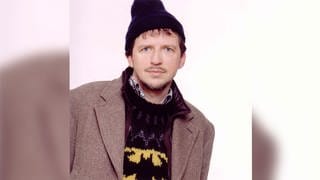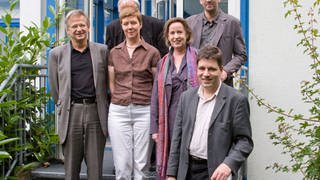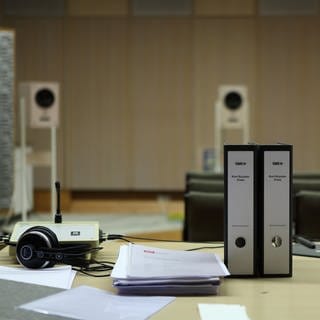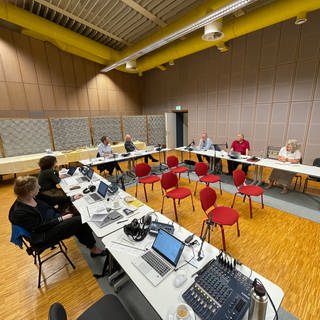With the disappearance of a bird species, its song also falls silent. Since 1600, an estimated 150 bird species have become extinct. In addition to the remains in natural history collections in the form of skins, skeletons, and eggs, there are also a number of contemporary scientific descriptions. However, very few of these include information about the bird's voice.
In the Séance vocibus avium, Wolfgang Müller analyzes the language of scientists, explorers and researchers who wanted and want to make the bird and its environment comprehensible and vivid. What language is used, what does it sound like? Which words are used to reconstruct the shape and nature of the extinct bird? The voice of Claudia Urbschat-Mingues creates images of new, never-before-seen birds in strange and familiar biotopes in a linguistic séance.
Wolfgang Müller also asked ten musician friends of his to reconstruct the silenced bird's song as naturalistically as possible according to existing scientific data.
The bird voices are created by Justus Köhnke, Annette Humpe, Frederik Schikowski, Frieder Butzmann, Hartmut Andryczuk, Max Müller, Nicholas Bussmann, Wolfgang Müller, Françoise Cactus, Brezel Göring, Khan, Namosh and Kristbjörg Kjeld. To do this, they dissolve their identity as musicians and artists and transform themselves into a specific, extinct bird, which they now embody through its song. The result is neither music nor sound art, but sound poetry never heard before.
Back in 1994, Wolfgang Müller reconstructed the sounds of the North Atlantic giant lark (alca impennis), originally native to Europe and now completely extinct, in Reykjavík for his BR radio play Das Thrymlied. Its sounds were heard for the last time in 1844 by three Icelandic sailors when the last specimens were killed and were described in an article by the Cambridge scientist Dr. Alfred Newton in the journal Ibis (1858).
Production: Bayerischer Rundfunk
Premiere: August 3, 2008
Jury statement and competition 2009
"The artist and field researcher Wolfgang Müller takes scientific descriptions of extinct bird species and their voices as the starting point for his audio work 'Séance vocibus avium'. From the extinct form of a radio lecture, he develops an initially seemingly sober text structure, only to then playfully transform the sentences into word sequences and fields of meaning. In this way, attention is drawn away from the original context of the zoological presentation and towards the poetic sounds and meanings of the individual words. Bird names, exotic habitats and the verbal notations of vocalizations create broad fields of imagination in the eleven text passages, each of which is followed by a beguiling reconstruction of lost bird calls by human interpreters. 'Séance vocibus avium' enchants with its delight in inventing realities."
In total, 88 competition entries from 16 countries were submitted in 2009, including 40 productions by freelance authors. The award ceremony took place on October 17 as a public event within the framework of the Donaueschinger Musiktage 2009.
An independent jury decided on the awards. The members were the publicist, literary scholar, and former Minister of State for Culture Christina Weiss (Chair), the writer Marcel Beyer, the composer Helmut Oehring, the literary scholar Klaus Ramm, and the journalist and musicologist Margarete Zander.
Prize winner
Wolfgang Müller was born in 1957 in Wolfsburg, Lower Saxony. In 1979, he moved to Berlin and co-founded the project Die Tödliche Doris with Nikolaus Utermöhlen in 1980. Concurrently, he began studying Experimental Film Design at the University of the Arts Berlin (now UdK). With Die Tödliche Doris, he explores a question posed by Marcel Duchamp: Can one create something that is not art? Wolfgang Müller expands this question to ask: Can one create something with sound, tone, and noise that is not music?
Die Tödliche Doris, with changing line-ups, created numerous unmusical, non-musical, and supra-musical works in pursuit of this question. In 1981, they collaborated with deaf friends such as sign language performer Gunter Trube, and in 1983, they introduced Chöre & Soli, a record box comprising eight double-sided mini-phonograph records and a battery-operated player — originally a patent developed for speaking puppets.
In 1987, Wolfgang Müller announced the release of an "invisible fifth long-playing record." This is created when the long-playing record Unser Debüt (1984) is played simultaneously with the corresponding A or B side of its counterpart, the LP sechs by Die Tödliche Doris, released in 1986, on separate record players. Both productions interact temporally, textually, and musically with each other, resulting in a new whole, namely the world's first invisible long-playing record.
With Die unsichtbare LP Nr. 5, Die Tödliche Doris concludes its existence in 1987. This led them, among other places, to the Musée d'Art Moderne Paris (1982), The Museum of Modern Art New York (1987), Club Quattro Tokyo (1987), Halla Gwardii Warsaw (1987), Petöfi Scarnok Budapest (1986), and made them an official participant of documenta 8 in Kassel and the Bierfront Festival in Aachen (1987).
Wolfgang Müller dissolved Die Tödliche Doris in 1987 into an Italian white wine brand called Vino di tavola bianco. He presented this wine in 1988 at the Kunsthalle Hamburg and also served it there. In parallel with the release of Michel Jackson's LP BAD, Wolfgang Müller released his first solo LP BAT in 1989. On it, the vocalizations of eight native bat species can be heard, known as "knalls," which were translated from the ultrasonic range to audible frequencies for humans using a sound detector and were made audible on record for the first time.
BAT was a flop. While BAD became one of the best-selling LPs of the century, Wolfgang Müller could only sell the last of his total of one thousand BAT LPs almost twenty years later, in 2007. (However, BAT is a sought-after collector's item and is already being traded at significantly higher prices than BAD.)
After a visit to Iceland in 1990, Wolfgang Müller's interest increasingly focuses on the polar island in the North Atlantic. He now signs emerging sound and art works with the Icelandic translation of his name, Ülfur Hräöölfsson. As such, in 1996, he realized Thrym Song - Island Notes by Ülfur Hrödölfsson, an audio play production for Bayerischer Rundfunk. It contains the reconstructed sounds of a bird extinct off the coast of Iceland in 1844, the flightless Great Auk (Alca impennis), and the voices of Icelandic actors delivering German texts with an Icelandic accent. In 1997, Blue Tit — das deutsch-isländische Blaumeisenbuch is published by Martin Schmitz Verlag, which extensively documents Wolfgang Müller's scientific-artistic research and methodology for the first time.
In Norway, where Kurt Schwitters lived in exile, Wolfgang Müller believes in 1994 to have heard an interpretation of the lost Ursonate from the starlings living there. In 2000, he presents the project House Music - Starlings Singing Kurt Schwitters on Hjertaya. He poses the question: Do the starlings - according to information from Prof. Dr. Böhner, now spanning over fifty generations - imitate Kurt Schwitters' Ursonate on this island? Following its publication, Wolfgang Müller receives a summons from the copyright holder of the Ursonate, Kiepenheuer Bühnenvertriebs GmbH. Prompted by this, he explores the question: Can starlings infringe copyright? He examines these and other questions in his book "Neues von der Elfenfront - Die Wahrheit über Island," published in 2007 by Edition Suhrkamp.
In 1998, Wolfgang Müller stages "Deaf Music - Die Tödliche Doris" in sign language at the Prater of the Berliner Volksbühne. Texts and music of his production are transformed interactively in space by sign language interpreters Dina Tabbert and Andrea Schulz through their bodies and gestures. This makes the music copyright-free. "I am not aware of a collecting society that takes over the rights to such works." (Dr. Ina Hölscher, GEMA). The eponymous DVD is released in the Edition tothenhayn and is first presented in 2006 at the Berlin Deaf Center on Friedrichstrasse.
As a professor of experimental sculpture, Wolfgang Müller teaches at the HfBK Hamburg in 2001/2002, raising questions about the morphology of elves and dwarves. In the same year, he publishes, in the Walther von Goethe Foundation he founded, J. W. von Goethe's attempt to explain the metamorphosis of plants (Gotha 1790) in Icelandic first translation by the Icelandic lecturer at the University of Vienna, Jon B. Atlason.




